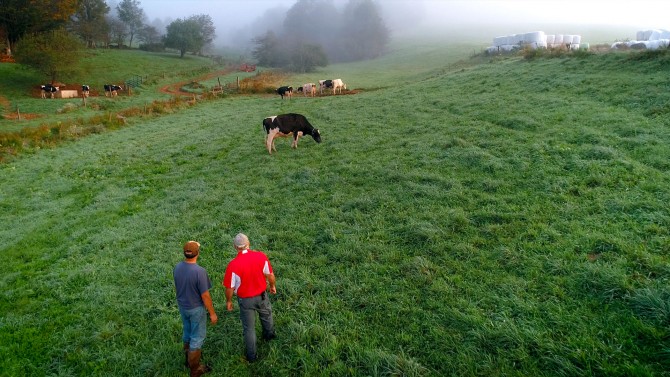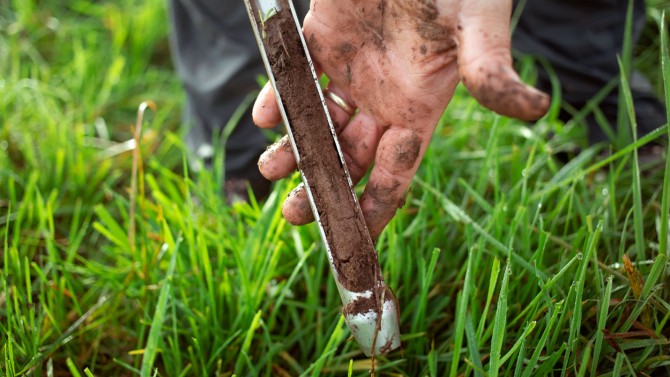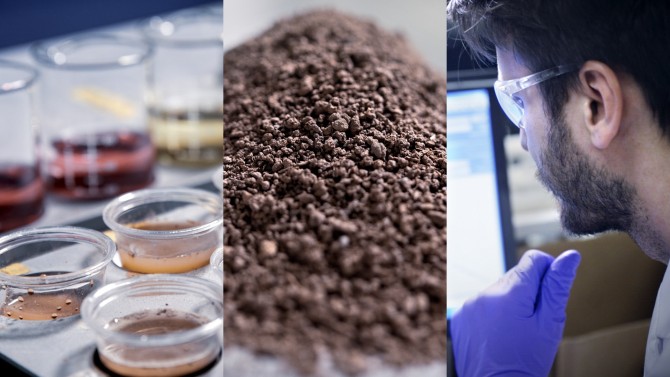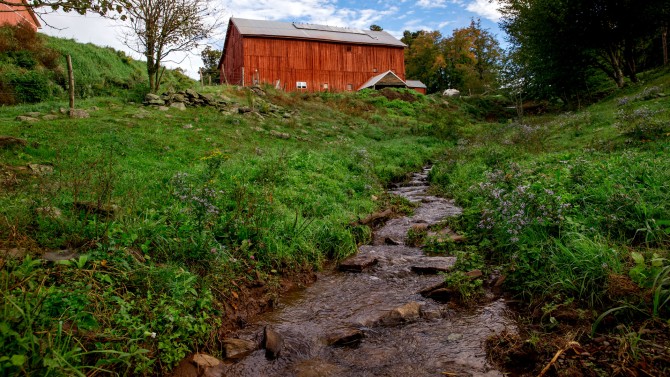Cornell expertise helps deliver clean, safe water to NYC
By Blaine Friedlander
At a wood-fired pizzeria in Brooklyn, a worker washes her hands before preparing a thin-crust pie; a mechanic living in a fifth-floor East Harlem walkup boils fresh string beans to feed his family; and a first-grader in Manhattan stops for a sip at her school’s drinking fountain.
Millions of times each day, New Yorkers turn on the faucet, relying on water supplied from about 125 miles away in the Catskill Mountains. The New York City Department of Environmental Protection is charged with getting clean water from the mountains to the city, and it taps Cornell expertise to help keep the city’s award-winning water pristine – and affordable.
‘The water starts here’
Delaware County, with breathtaking scenery in the Catskills, is home to the watershed’s headwaters.
Dennis Reinshagen tends to Holstein and Jersey cows in South Kortright, New York. On dry days, he walks the cows from the barn to a rotation of pastures for grazing. Each cow produces about 22,000 pounds, or 2,500 gallons, of milk annually, and Reinshagen perpetually organizes feed, milks his cows and spreads manure. But he remains mindful that his farm and hundreds of others nearby affect another important resource: the drinking water of 9.6 million people in and around New York City.
“The water starts here,” said Reinshagen. “It’s something to be proud of.”
Behind every drop of clean water traveling from Delaware County is a team of Cornell Cooperative Extension educators and Cornell faculty scientists who partner with farmers, local and federal agencies and municipalities to develop custom plans to protect nearby streams from runoff and keep drinking water safe.
“Water quality is important to people who live in New York City.”
Dennis Reinshagen, Farmer
“Water quality is important to people who live in New York City, and it is important to farmers, too, as the watershed helps keep agriculture sustainable,” he said. “A dairy cow drinks 30 to 50 gallons of water a day, and milk is about 87 percent water – so it’s in my best interest to maintain good water quality.”

NYC residents enjoy clean, safe and famously great-tasting drinking water, thanks in part to Cornell expertise.
Reinshagen’s hilly farm encompasses Rose Brook, a healthy stream that empties into the West Branch Delaware River about a mile away. From there, the water meanders through the agrarian countryside – through the towns of Stamford, Delhi and Walton – until it reaches the Cannonsville Reservoir about 50 miles away.
“This water running down Rose Brook cutting through Dennis Reinshagen’s farm will be in the Cannonsville Reservoir by tonight. It’s an amazingly short transit time between here and the reservoir – it’s hours,” said Dale Dewing M.S. '97, a senior team leader on the Watershed Agricultural Program for Cornell Cooperative Extension of Delaware County. “The water from this brook could be flowing out of a New York City tap within days, without going through filtration.”
The Delaware watershed is part of the largest municipal water supply in the United States, and because it requires no filtration, it saves New Yorkers billions of dollars. The entire water supply system covers more than 1 million acres or about 2,000 square miles (about the size of the state of Delaware), delivering about 1 billion gallons of water daily through a vast infrastructure of reservoirs, aqueducts, tunnels and pipes to a million residents in Orange, Putnam, Ulster and Westchester counties and 8.6 million New York City residents.
Nineteen reservoirs on both sides of the Hudson River supply the city’s water. The older, original watersheds closer to the city and east of the Hudson River require filtration. But west of the Hudson, about 125 miles northwest of Broadway, the Catskill/Delaware Aqueduct’s six major reservoirs – Cannonsville, Pepacton, Rondout, Neversink, Ashokan and Schoharie – supply the unfiltered bulk.

Farmer Dennis Reinshagen, left, consults with Cornell Cooperative Extension’s Dale Dewing on watershed issues.
Working with the farms
Cannonsville, one of the largest reservoirs, is surrounded by nearly 200 dairy, beef, sheep and goat farms. Seven full-time professionals from Cornell Cooperative Extension offer best-management practices backed up by science and experience. They help the farms manage soil excellence, produce high-quality crops, feed balanced rations, maintain herd health and prevent manure runoff from wending its way into the streams that supply New York City taps.
“We look at what’s going into the cow, and we estimate what’s going to come out,” said Mindy Gaida, a medic during the Iraq War who has returned to rural life as a Cornell Cooperative Extension community educator in Delaware County.
“The water from this brook could be flowing out of a New York City tap within days...”
Dale Dewing, Cornell Cooperative Extension Professional
Gaida works daily with farmers to create management plans that will prevent manure and bacteria from reaching streams, while keeping farms profitable and sustainable. It’s far from a desk job. Gaida walks the pastures and barn stalls, taking feed and soils samples. The extension team helps farms apply the latest Cornell research in animal science and agronomy; and it sends soil, feed and manure samples to Agro-One and Dairy One labs in Ithaca for testing, using methods recommended by Cornell.
Like a special operations unit, this CCE team is under contract with the Watershed Agricultural Council, where environmental, agricultural and governmental partners from New York City, Albany and the Catskills work together to maintain the clean watershed.

Cornell Cooperative Extension educators collect soil samples from farms throughout the New York City watershed.
Safe, affordable drinking water
The Safe Drinking Water Act of 1974 guides municipal water systems throughout the U.S., and the U.S. Environmental Protection Agency sets the standards. In the late 1980s, new surface water treatment laws took effect, and the EPA informed New York City that it would need to build a filtration plant – with a likely price tag of $5 billion in 1990 dollars (nearly $10 billion today) – but the city knew the water was already pristine.
New York City’s Department of Environmental Protection (NYCDEP), which has jurisdiction over the reservoirs and the surrounding land, sought a rarely granted “filtration avoidance” variance from the EPA. To qualify, the department needed to enlist the support of farmers, residents and other stakeholders in the watershed to keep the water clean.
Initially the upstate farmers and towns successfully fought NYCDEP’s proposed rules, but acrimony gave way to voluntary cooperation in 1992, when the city agreed to fund the Watershed Agricultural Program. By 1997, the city and watershed communities in the Catskills signed a landmark memorandum of agreement – where communities around the watershed agreed to be good stewards, and the city would pay for various partnership programs and protect the quality of water flowing into its reservoirs.
The EPA granted a temporary filtration avoidance variance in 1992, and thanks to the work of the watershed partnership, it has been renewed ever since. The New York State Department of Health took over the task of issuing filtration avoidance determinations in 2007.

Soil, feed and manure samples are sent to Agro-One and Dairy One laboratories in Ithaca for testing.
‘Science was the key’
For years Cornell’s New York State Water Resources Institute had been providing ad hoc help and practical knowledge for the watershed region, so it was natural for the agencies and farmers to turn to the university for scientific guidance. “The various organizations needed a framework to work together,” said Karl Czymmek ’86, senior extension associate in Cornell’s PRO-DAIRY Program, which assists New York’s dairy industry in economic development.
Sound science is Cornell’s calling card. “Science was the key,” he said.
Cornell Cooperative Extension educators work with farmers to develop and implement plans for nutrient management and precision feed management, and provide best practices to reduce a farm’s whole farm nutrient mass balances for nitrogen, phosphorus and potassium. Also, the educators provide a steady supply of training classes for farmers year-round.
Paul Cerosaletti ’89, M.S. ’98, an agronomist and dairy cattle nutritionist, is the precision feed and nutrient management team leader for Cornell Cooperative Extension of Delaware County. He’s spent his career keeping water in the Catskills clean.
Dairy cows ingest phosphorus because it is naturally present in their feed, but excess phosphorus can run into local streams and increase the likelihood of algae blooms in waterways. Cerosaletti and his team work with farmers to avoid overfeeding phosphorus to cows, thereby reducing the element in manure. They also help farmers recycle nutrients more efficiently in crops grown on the farm and improve animal productivity to export more nutrients off the farm. All of this not only helps mitigate the threat of water pollution, it has the added benefit of keeping cows healthy, reducing costs and increasing income from milk sales.
“Importantly, we went from developing the science to implementation on a large scale across a number of farms. … It’s more than a field-laboratory experiment,” Cerosaletti said. “It’s a water-quality program implemented across farms that’s efficient and fits into the conservation world.”
Twenty years ago, professionals working in the watershed were among the few around the country to develop and execute this style of precision feed management, Cerosaletti said. “It went from the laboratory to on-farm research trials, and then we replicated the on-farm trials here in the New York City watershed,” he said.

Mike Van Amburgh, professor of animal science, developed one of the world’s most widely used cattle nutrition models.
Back on Cornell’s Ithaca campus, the tools continue to be improved. Mike Van Amburgh, professor of animal science, is the driving force behind the Cornell Net Carbohydrate and Protein System, now one of the most widely used cattle nutrition models in the world. Cornell Cooperative Extension educators input a farm’s data into the model to evaluate the cattle rations and use the model’s output to develop detailed, precision feed management recommendations.
“We can tailor decisions to the forages and the cow to create a diet that maximizes cow health and minimizes the environmental impact of food production,” said Van Amburgh.
At the Cornell Nutrient Management Spear Program, led by professor Quirine Ketterings, online tools, worksheets, software programs, and soil and plant tests are available through the Cornell On-Farm Research Partnership. Best management practices are tested through this partnership.
“The nutrient mass balance software is an accounting approach,” Ketterings said. “We can calculate how much phosphorus, nitrogen and potassium arrives at the farm and then how much of it leaves by way of milk production – and how much stays on the farm and is potentially subject to loss to the environment.”
The goal is to assist the watershed’s dairy farmers in spreading nutrient-rich manure in an environmentally sensitive way, and to balance animals and cropland so manure improves soil health, but its nutrients do not trickle into drinking water.
Results matter
The partnership between the farmers, governmental agencies and Cornell is unique. “You don’t really see this around the country, but it is an integral part of our watershed program,” said Craig Cashman, executive director of the Watershed Agricultural Council. “This kind of expertise is critical to watershed success. Cornell scientists and Cornell Cooperative Extension bring a skill set that is unmatched by anybody else.”
“Cornell scientists and Cornell Cooperative Extension bring a skill set that is unmatched by anybody else.”
Craig Cashman, Watershed Agricultural Council
From the 1980s into the 1990s, relatively high amounts of phosphorus were flowing into the Cannonsville Reservoir from watershed farms and poorly functioning wastewater treatment plants. After the landmark watershed agreement, NYCDEP began to fund upgrades to wastewater treatment plants in the Catskills and mitigate farm runoff in streams above the reservoir. These projects caused the amount of phosphorus going into Cannonsville to drop by 55 percent, and 51 percent at nearby Pepacton Reservoir, from the late 1980s to 2010, according to the agency’s statistics.
Video: Cornell expertise helps keep drinking water safe for 8.6 million NYC residents.
To monitor that the water remains excellent, the NYCDEP tests the water about 1.8 million times a year. Nearly 1.2 million tests are conducted by the agency’s robotic monitoring network, and about 600,000 tests are conducted by the agency’s scientists, who take samples from the reservoirs, aqueducts and sampling stations in the city’s five boroughs.
The integrated partnership has worked like a machine for decades now, and the processes have evolved, says PRO-DAIRY’s Czymmek. Cornell continues to develop science, plans and programs to benefit upstate farmers and communities – and millions of consumers in the New York City area who rely on more than 1 billion gallons of clean, clear and famously fresh drinking water each day.
Patrick Palmer is chief of the New York State Department of Health’s New York City Watershed Section in the Bureau of Water Supply Protection, the agency now responsible for issuing the watershed’s filtration avoidance determinations.
“The New York State Department of Health appreciates the contributions from Cornell University and Cornell Cooperative Extension to the partnerships that protect New York City’s watershed,” Palmer said. “Their work ensures that the highest levels of drinking water quality are maintained for New York City and upstate consumers” – including that little girl taking a sip from her school’s water fountain.
New York State Impact
Cornell expertise helps deliver clean, safe water to NYC
Media Contact
Get Cornell news delivered right to your inbox.
Subscribe




